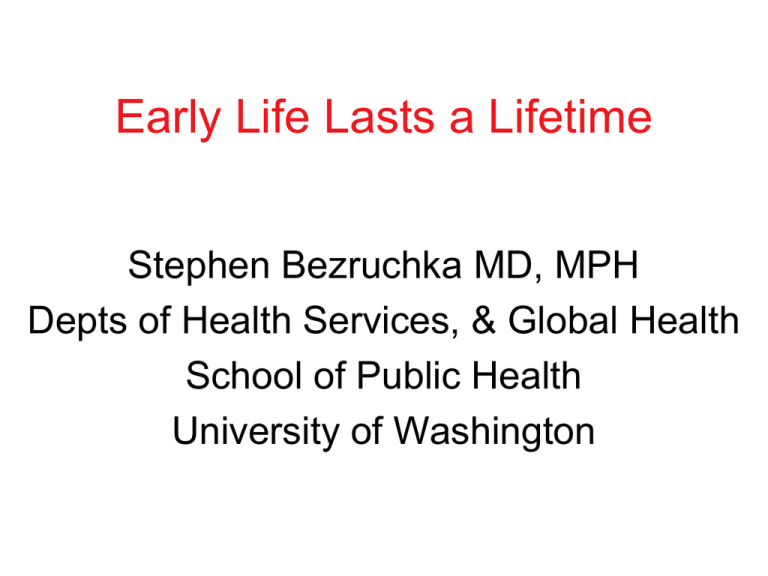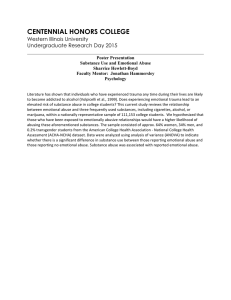Early Life Lasts a Lifetime
advertisement

Early Life Lasts a Lifetime Stephen Bezruchka MD, MPH Depts of Health Services, & Global Health School of Public Health University of Washington Key ideas Talked here before -about inequality and worse health outcomes -about economic growth in rich countries limiting health improvements BIG IDEA Early life (first 1000 days) is when half of health as adults is programmed Population Health Concepts Health has been improving most of the last century Health improvements are not shared equally Poorer people have poorer health Early life is most critical period for health US WOMEN YEARS LEFT AT AGE 50 haven’t kept pace since 1955 Glei et al. 2010 Population Health Concepts Health has been improving most of the last century Health improvements are not shared equally Poorer people have poorer health Early life is most critical period for health QUIZ If you are a girl aged 15 in which country do you have a better chance of reaching age 60? United States or Sri Lanka Sri Lanka US Adult Female Mortality 1970-2010 YOUR EARLY LIFE? Life course health model DEVELOPMENTAL ORIGINS BIOLOGY Fetal and subsequent GROWTH Ovum made maternal grandmother’s womb Fertilized ovum (zygote) divides ~42 times to produce newborn Further ~5 cycles of cell division to produce adult Erection to Resurrection First 1000 days: 9 months in mother – starting in maternal grandmother First two years outside HALF of adult health programmed SENSITIVE DEVELOPMENT PERIODS Moore et al. 2003 Early Life Natural Experiments Hurricane Katrina HIGH EXPOSURE: – Pre-term delivery, – Low Birth Weight World Trade Center 911 Dutch Hunger Winter Increase LBW exposure at periconception and first two trimesters & PTD Dutch hunger winter November 1944-May 1945 Mental disorders Roseboom et al. 2006 Poor Pregnancy Conditions Related to entire life history of woman before she become pregnant Impacted by parents Impacted by grandparents Impacted by previous generations womb with a view Poor Pregnancy Conditions Increased Risk of EARLY – – – – – – Pre-term Delivery Low Birth Weight Caesarian Section Infant Mortality Behavioral Problems Poor School Performance LATER LIFE Earlier reproduction Cardiovascular Disease Obesity Metabolic syndrome Diabetes Hypertension Common Cancers Early death Poor Pregnancy Conditions Increased Risk of EARLY – – – – – – Pre-term Delivery Low Birth Weight Caesarian Section Infant Mortality Behavioral Problems Poor School Performance LATER LIFE Earlier reproduction Cardiovascular Disease Obesity Metabolic syndrome Diabetes Hypertension Common Cancers Early death LBW (proxy) associated with Hypertension Type 2 diabetes Obesity, metabolic syndrome Coronary heart disease Stroke Osteoporosis Depression and psychoses (e.g. schizophrenia) Age-related cognitive impairments Chronic renal failure Altered gonadal responses Altered immune responses Overall reduced life expectancy Seckl, J. R. and M. C. Holmes (2007). "Mechanisms of Disease: glucocorticoids, their placental metabolism and fetal 'programming' of adult pathophysiology." Nature Clinical Practice Endocrinology & Metabolism 3(6): 479-488. MOTHERHOOD A girl is a mother from the time of her own conception Differential Exposures in US Over Lifetime Lu & Halfon 2003 Intergenerational Stress Prenatal psychosocial stress Cytokine production in women offspring (34 subjects and 28 comparison) mean age 24, healthy Pregnancy stress: divorce, breakup, paternity denial, marital infidelity, death of partner, parent, child, illness in other (cancer, MI, stroke), financial problems (loss of house by flooding, husband unemployed, foreclosure, MVA, unmarried (father not accepted by family), political refugee (Entringer et.al. 2008) IMMUNE SYSTEM TESTING of lymphocytes: Production: no difference Activation in vitro phytohemaglutinin (PHA) induced cytokine production Efficacy not tested PS = Prenatal Stress PS CG IFN interferon Entringer et. al. 2008 UNICEF League Table of Child Well-Being Wilkinson & Pickett 2009 Spirit Level Child Well-Being Stressful early life on girls Reach sexual maturity at earlier age If brought up without a father: – More likely to become sexually active earlier – More likely to become pregnant Likely hormonal prompting, than conscious decision – If conditions tougher, better to breed early & often, putting less investment into each child – If conditions easier, better to wait until you have partner and make larger investments in fewer children – BALANCE: quantity vs. quality Stressful early life on boys Increases risk taking among young men – Low-status males with little or no access to females are to avoid "one-way road to genetic nothingness," they may have to be aggressive and adopt high-risk strategies – Rates of violence higher among young men in deprived areas, and see higher accident rates, other behaviors with pronounced social gradient Biological Embedding Of Childhood Adversity Etches et al. 2006 UNICEF League Table of Child Abuse Deaths Rate of Child abuse and Neglect er 1,000 children (0-17 years), Alaska and U Only Washington, DC has a higher rate US Prevalence of Individual Adverse Childhood Experiences Adverse Child Experiences (ACE) Abuse – emotional - recurrent humiliation (11%) – physical - beating, not spanking (28%) – contact sexual abuse (28% women, 16% men; 22% overall) Household dysfunction mother treated violently (13%) household member was alcoholic or drug user (27%) household member was imprisoned (6%) household member was chronically depressed, suicidal, mentally ill, in psychiatric hospital (17%) not raised by both biological parents (23%) Neglect physical (10%) emotional (15%) Felitti et. al.Kaiser San Diego studies Effect of ACEs on Death Rate ACE Score and Rates of Antipsychotic Prescriptions (Null hypothesis) Age Group 19-34 35-49 50-64 >=65 50 40 30 20 10 0 0 2 ACE Score 4 12 Prescription rate (per 100 person -years) Percent in Age Group 60 10 8 6 4 2 0 0 1 2 3 ACE Score 4 >=5 Life course health model pathway LATENT Conception cumulative MEDICAL CARE impact on Early Life? What to do? Doyle et. al. 2009 Trauma Informed Care & Adverse Childhood Experiences (ACE) Chanda K. Aloysius, MBA Vice President and Laureen Young, LMFT Clinical Supervisor Dena A Coy Residential and Outpatient Behavioral Services Southcentral Foundation National Prevalence of Trauma • 90% of public mental health customers have been exposed to trauma (Mueser et al., 2004; Mueser et al., 1998) • Most have multiple experiences of trauma (Ibid) • 34-53% report childhood sexual or physical abuse (Kessler et al., 1995; MHA NY &NYOMH, 1995) • 43-81% report some type of victimization (Ibid) • Boys who witness domestic violence are 2x’s more likely to abuse their own partners and children when they become adults (Strauss, Gelles, Smith, 1990) “Many providers may assume that abuse experiences are additional problems for the person, rather than the central problem…” (Hodas, 2004) Summary • Prevention is possible: – To date, prevention studies have explored whether a specific intervention reduces abuse. – A more important question is how to create optimally effective prevention programs – An integrated prevention model may be more effective (e.g., linking FWWI, quality birth experience and improved parenting skills). Summary • - Trauma Informed Care as an intervention: Discuss AST and CSR at intake PTSD screening at intake Safety groups for PTSD and SUD Trauma Sensitive Yoga and Prenatal Yoga Mindfulness, traditional values and healthy relationships - Baby massage Typical disease approach Traditional RISK FACTORS?? medical management Life course birth DEATH PREVENTION Primary Secondary tertiary SOCIETAL HEALTH approach CHRONIC DISEASE RISK PRIMORDIAL PREVENTION Trans-generational Conception DEATH Higher Taxes Social Safety Net “The legitimate object of government is to do for a community of people whatever they need to have done, but can not do, at all, or can not so well do, for themselves.” WHAT WOULD WARREN DO? Don't Lower Corporate Taxes Levy Higher Taxes On The Rich No Foreign-profit Repatriation moral hazard Curb Speculative Gains Get Tough On Directors forfeit five years' pay if bailed out Get Rid Of Private Schools So rich invest in K-12 Reform Health Care tapeworm POLICY PRIORITIES PAID FAMILY LEAVE PAID PRENATAL LEAVE DECREASE GAP BETWEEN RICH AND POOR TO PAY FOR LEAVE POLICIES PRENATAL PAID LEAVE Chile: 6 weeks mandatory paid prenatal leave OECD 2009 164 countries have laws saying those who work are guaranteed paid maternity leave. only countries that don't Papua New Guinea Liberia, Swaziland United States of America DEMOCRATIC CAPITALISM Crisis DEMOCRATIC CAPITALISM 3 Crises After WWII social security & rising standard of living, employment 1) Inflation in 1970s DEMOCRATIC CAPITALISM 3 Crises After WWII social security & rising standard of living, employment 1) Inflation in 1970s led to unemployment Volcker shock 2) Public debt 3) Private debt US Crises of Democratic Capitalism 1970-2010 First CRISIS Second CRISIS Third CRISIS Streeck 2011 Inflation Rates 1970-2010 Ravaillon 2010 Streeck 2011 Harvey 2005 Streeck 2011 Unemployment Rates 1970-2010 Strike Volume 1970-2010 Streeck 2011 Fiscal consolidation, private debt (% GDP), 1995−2008 Streeck 2011 http://www.phac-aspc.gc.ca/ph-sp/determinants/index-eng.php Population Health CAUSAL concepts Do POORER People Have POORER PROTOPLASM? Hegewald et. al. 2007 164 countries have laws saying those who work are guaranteed paid maternity leave. only countries that don't Papua New Guinea Liberia, Swaziland United States of America OECD 2009 Rate of Child abuse and Neglect er 1,000 children (0-17 years), Alaska and U Only Washington, DC has a higher rate QUIZ If you are a boy aged 15 in which country do you have a better chance of reaching age 60? Peru or United States Peru US Adult Male Mortality 1970-2010




